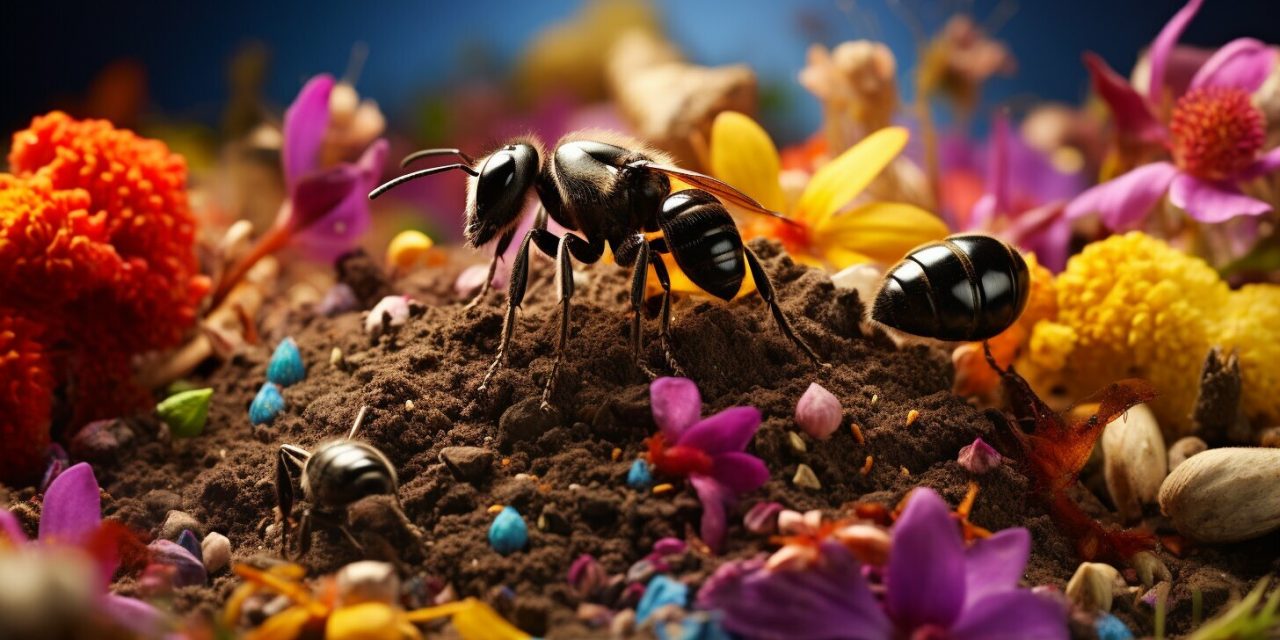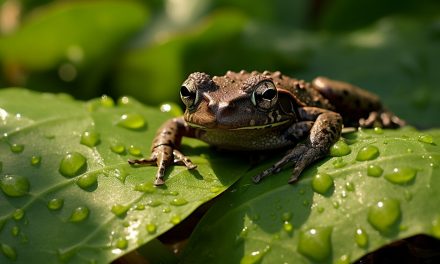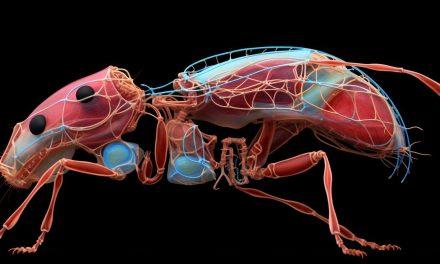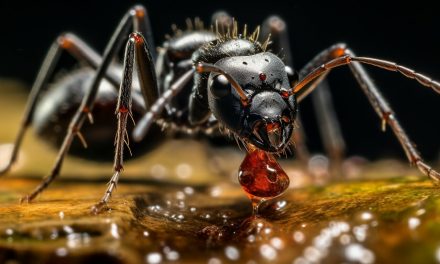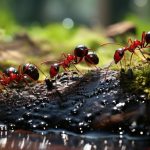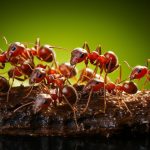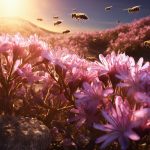This post may contain affiliate links.
Welcome to our exploration of ant pollination! In this article, we will uncover the truth behind the question, “Do ants pollinate?”
Key Takeaways:
- Ants are not considered important pollinators due to their small size and limited ability to carry and transfer pollen.
- Some species of ants can have a negative impact on pollination by secreting a substance that kills pollen grains.
- Ant-pollinated plants typically have low-growing, inconspicuous flowers that are close to the stem.
- Ants may serve as pollinators in certain circumstances, such as when smaller plants occur in high density or when effective winged pollinators are scarce.
- Examples of ant-pollinated plants include Small’s stonecrop, alpine nailwort, and Cascade knotweed.
The Role of Ants in Pollination
Let’s take a closer look at the role of ants in pollination and understand how they contribute, or don’t contribute, to this crucial ecological process. While ants are known to visit flowers and collect nectar, they are not considered important pollinators like bees or butterflies. In fact, some species of ants have been found to have a negative impact on pollination.
Ant-pollinated plants are typically low-growing and have small, inconspicuous flowers that are close to the stem. These plants have evolved to rely on ants for pollination under specific circumstances. For example, when smaller plants occur in high density or when effective winged pollinators are scarce. However, ants may also damage plants’ reproductive organs and interfere with pollination.
Ants’ small size and smooth bodies make it difficult for pollen to attach to them, and their mandibles are not well-suited for collecting nectar. Some ants even secrete a natural substance that kills pollen grains, further reducing their potential as pollinators. While ants can serve as pollinators in certain cases, ant pollination is generally rare and limited to a few species within different plant families.
| Examples of Ant-Pollinated Plants | Characteristics |
|---|---|
| Small’s stonecrop | Low-growing succulent with small, star-shaped flowers |
| Alpine nailwort | Short, herbaceous plant with inconspicuous flowers |
| Cascade knotweed | Low, spreading plant with small, pink flowers |
In conclusion, while ants may play a limited role in pollination, they are not considered significant pollinators compared to other insects. Ant-pollinated plants have evolved unique characteristics and rely on ants under specific circumstances. However, ants’ small size, smooth bodies, and eating habits make them less efficient at carrying and transferring pollen. Therefore, bees, butterflies, and other winged insects remain the primary drivers of plant pollination in most ecosystems.
Ant-Mediated Pollination: Fact or Fiction?
Is ant-mediated pollination a reality or just a myth? Join us as we delve into the scientific evidence regarding ants as pollinators. While ants are known to visit flowers and collect nectar, they are not considered important pollinators like bees or butterflies. In fact, some species of ants can have a negative impact on pollination due to their secretion of a natural substance that kills pollen grains. Thus, the role of ants in pollination is a topic of debate among scientists.
Ant-pollinated plants are typically low-growing and have small, inconspicuous flowers that are close to the stem. These plants have evolved to attract and utilize ants for pollination. Due to their small size and smooth bodies, ants are not well-suited for carrying and transferring pollen. Their mandibles are also not designed for collecting nectar effectively. As a result, the chances of effective pollination through ants are limited.
However, there are certain circumstances where ants can serve as pollinators. For example, when smaller plants occur in high densities or when effective winged pollinators are scarce, ants may step in to assist with pollination. Yet, even in these cases, ants can also damage plants’ reproductive organs and interfere with the pollination process.
Some examples of ant-pollinated plants include Small’s stonecrop, alpine nailwort, and Cascade knotweed. These species have specific adaptations that facilitate pollination by ants. Nevertheless, it is important to note that ant pollination remains rare and limited to a few species within different plant families.
| Ant-Pollinated Plants | Characteristics |
|---|---|
| Small’s stonecrop | Small, inconspicuous flowers close to the stem |
| Alpine nailwort | Nectar production near the base of the flowers |
| Cascade knotweed | Flowers with specialized structures that facilitate ant access |
In conclusion, ants can play a minor role in pollination under specific circumstances, but they are not significant pollinators overall. While they may visit flowers and collect nectar, their small size and smooth bodies make it difficult for them to effectively carry and transfer pollen. Additionally, some ant species have been found to hinder pollination due to the secretion of substances that harm pollen grains. Therefore, while ant-mediated pollination exists to some extent, it remains a rare phenomenon limited to a few plant species.
The Importance of Ants in Plant Pollination
Discover the surprising importance of ants in plant pollination and unveil fascinating facts about their role in specific plant families. While ants are not considered major pollinators like bees or butterflies, they do play a role in certain circumstances. Ants are known to visit flowers and collect nectar, but their small size and smooth bodies make it difficult for pollen to attach to them. Additionally, their mandibles are not well-suited for collecting nectar.
Some species of ants can even have a negative impact on pollination. These ants secrete a natural substance that kills pollen grains, hindering the pollination process. However, despite these limitations, ants can serve as pollinators in certain situations. This is especially true when smaller plants occur in high density or when effective winged pollinators are scarce.
Ant-pollinated plants are typically low-growing and have small, inconspicuous flowers that are close to the stem. These plants have evolved specific adaptations to attract ants, such as producing extrafloral nectaries or offering specialized structures for the ants to inhabit. Some examples of ant-pollinated plants include Small’s stonecrop, alpine nailwort, and Cascade knotweed.
| Ant-Pollinated Plants | Characteristics |
|---|---|
| Small’s stonecrop | Low-growing succulent with small, star-shaped flowers |
| Alpine nailwort | Tiny, inconspicuous flowers clustered near the base of the stem |
| Cascade knotweed | Small, white flowers positioned close to the stem |
While ant pollination is relatively rare and limited to a few species within different plant families, it highlights the intricate relationships between organisms in nature. Understanding the role of ants in pollination expands our knowledge of the diverse mechanisms that plants have evolved to ensure their reproductive success.
Ant Pollination: The Unique Characteristics
Learn about the distinctive characteristics of ant-pollinated plants and understand why they differ from those pollinated by other insects.
Ant-pollinated plants exhibit several unique traits that set them apart from their insect-pollinated counterparts. Firstly, these plants tend to be low-growing, with small and inconspicuous flowers that are often hidden close to the stem. Unlike showy flowers that attract bees and butterflies, ant-pollinated flowers may not possess vibrant colors or enticing fragrances. Instead, they rely on other means to capture the attention of ants.
One notable feature of ant-pollinated plants is the presence of extrafloral nectaries. These nectar-producing glands are located on different parts of the plant, such as leaves, stems, or even specialized structures, separate from the flowers themselves. By offering nectar outside of the flower, plants attract ants, which in turn provide protection from herbivores. This mutually beneficial relationship is known as myrmecophily.
Ant-pollinated plants have also evolved an interesting strategy to ensure successful pollination despite the challenges posed by ants. Their flowers often have relatively closed structures, with narrow openings and specialized appendages that guide the ants to the nectar source. These adaptations help prevent larger insects from accessing the nectar, ensuring that only ants, with their smaller size and ability to navigate tight spaces, can reach it.
The Unique Characteristics of Ant-Pollinated Plants:
- Low-growing plants with inconspicuous flowers close to the stem
- Extrafloral nectaries provide nectar outside of the flowers
- Closed flower structures and specialized appendages
While ant pollination is relatively rare compared to other forms of pollination, the distinctive characteristics of ant-pollinated plants highlight the fascinating adaptations that have evolved to promote this unique relationship. Understanding the specific traits of these plants allows us to appreciate the diversity of nature’s pollination strategies and the crucial role that ants can play in certain ecosystems.
| Ant-Pollinated Plant Examples | Scientific Name |
|---|---|
| Small’s Stonecrop | Sedum smallii |
| Alpine Nailwort | Paronychia montana |
| Cascade Knotweed | Polygonum cascadense |
Ants’ Impact on Pollination
Explore how ants’ actions can either help or hinder pollination and uncover instances where their presence has had detrimental effects on plants. While ants are not considered significant pollinators, they can play a role in certain circumstances. Some plant species, particularly those with low-growing and inconspicuous flowers, rely on ants as their primary pollinators. These plants often produce nectar-rich flowers that are positioned close to the stem, making it easier for ants to access them. The small size of ants allows them to move easily within dense vegetation, increasing the chances of successful pollination.
However, ants’ impact on pollination is not always beneficial. Their small size and smooth bodies make it difficult for pollen grains to adhere to them, limiting their effectiveness as pollinators. Additionally, some species of ants have been found to secrete a substance that can kill pollen grains, further hindering the pollination process. This negative effect is particularly pronounced in plants that rely on other pollinators, such as bees or butterflies, for successful reproduction.
Instances where ants have had detrimental effects on plants’ reproductive organs have also been observed. In some cases, ants may damage flowers or interfere with the transfer of pollen, preventing successful pollination. This is especially true when ants feed on floral resources such as nectar without providing any pollination services in return. In these situations, the presence of ants can reduce both the quantity and quality of pollination, potentially impacting the reproductive success of plant populations.
Ant-Pollinated Plant Examples
Although ant pollination is relatively rare, there are some notable examples of plants that rely on ants for the transfer of pollen. Small’s stonecrop (Sedum smallii), alpine nailwort (Paronychia pulvinata), and Cascade knotweed (Polygonum cascadense) are all examples of ant-pollinated plants. These plants have adapted specific traits, such as inconspicuous flowers and nectar rewards that attract ants, to ensure successful pollination.
A Summary of Ants in Pollination
“Ants can serve as pollinators in certain circumstances, such as when smaller plants occur in high density or when effective winged pollinators are scarce. However, their small size and smooth bodies make it difficult for them to effectively collect and transfer pollen, and some species even have detrimental effects on pollen grains. Ant pollination is limited to a few species within different plant families, and other insects, such as bees and butterflies, are generally more effective pollinators.”
In conclusion, while ants have the potential to contribute to pollination, they are not considered important pollinators in most cases. Their impact on pollination depends on various factors, and their presence can either support or hinder the reproductive success of plants. Ant pollination is a unique and specialized phenomenon that is limited to certain plant species within different families. Further research is needed to fully understand the ecological significance of ants in the pollination process.
| Ant-Pollinated Plants | Scientific Name |
|---|---|
| Small’s stonecrop | Sedum smallii |
| Alpine nailwort | Paronychia pulvinata |
| Cascade knotweed | Polygonum cascadense |
Ant-Pollinated Plants: Examples and Characteristics
Discover a fascinating array of ant-pollinated plants, including Small’s stonecrop, alpine nailwort, and Cascade knotweed, and learn about their distinctive traits. These plants have evolved unique characteristics that enable them to rely on ants for pollination, despite ants not being the main pollinators in most ecosystems.
Ant-pollinated plants have small, inconspicuous flowers that are typically low-growing and close to the stem. This arrangement allows ants to easily access the nectar and facilitates their movement between flowers. These plants often produce nectar in specialized structures called extrafloral nectaries, which are located on the leaves or stems and provide an additional incentive for ants to visit.
Unlike other pollinators such as bees or butterflies, ants do not have specialized body structures for pollen collection and dispersal. Their small size and smooth bodies make it difficult for pollen grains to attach to them. However, certain ant-pollinated plants have adapted to this limitation by producing sticky or adhesive pollen grains that adhere to the ants’ bodies as they visit the flowers.
| Plant Name | Characteristics |
|---|---|
| Small’s stonecrop | Succulent leaves, bright yellow flowers, grows well in rocky environments. |
| Alpine nailwort | Delicate white flowers, thrives in alpine meadows and rocky slopes. |
| Cascade knotweed | Tall plant with clusters of pink or white flowers, commonly found near streams or water bodies. |
Ant-mediated pollination is a fascinating phenomenon that showcases the intricate relationships between plants and insects. While ants may not be the primary pollinators in most ecosystems, they can serve as important pollinators in certain circumstances. The unique characteristics of ant-pollinated plants demonstrate nature’s ability to adapt and find alternative solutions to ensure successful reproduction.
Limitations of Ant Pollination
Let’s explore the limitations of ant pollination and understand why other insects often take precedence in the pollination process. While ants are known to visit flowers and collect nectar, they are not considered important pollinators. Some species of ants have even been found to have a negative impact on pollination due to the secretion of a natural substance that can kill pollen grains.
One of the reasons why ants are limited in their pollination abilities is the nature of ant-pollinated plants. These plants are typically low-growing, with small and inconspicuous flowers that are close to the stem. This structure makes it difficult for larger insects, such as bees and butterflies, to access the flowers and perform effective pollination. In such cases, ants can serve as pollinators, especially when smaller plants occur in high density or when effective winged pollinators are scarce.
However, ants also pose certain challenges to the pollination process. Their small size and smooth bodies make it difficult for pollen to attach to them, reducing their effectiveness as carriers of pollen. Additionally, ants’ mandibles are not well-suited for collecting nectar, further limiting their role in pollination. In some instances, ants may even damage plants’ reproductive organs and interfere with the pollination process.
Despite these limitations, there are a few examples of ant-pollinated plants, such as Small’s stonecrop, alpine nailwort, and Cascade knotweed. These plants have evolved specific adaptations to attract ants, such as offering specialized food rewards or creating structures that provide shelter for ants. However, it’s important to note that ant pollination is relatively rare and limited to a few species within different plant families.
| Ant-Pollinated Plants | Characteristics |
|---|---|
| Small’s stonecrop | Low-growing plant with inconspicuous flowers |
| Alpine nailwort | Tiny flowers close to the stem |
| Cascade knotweed | Specialized structures that attract ants |
In conclusion, while ants do have some limited involvement in pollination, other insects, such as bees and butterflies, are generally more effective pollinators. The unique characteristics of ant-pollinated plants, combined with the challenges faced by ants in carrying and collecting pollen, contribute to the relatively small role that ants play in the larger pollination process.
Conclusion: The Role of Ants in Pollination
In conclusion, while ants can occasionally assist with pollination, their role is generally limited, with other insects taking on the primary responsibility. Ants are known to visit flowers and collect nectar, but they are not considered important pollinators. Some species of ants have even been found to have a negative impact on pollination because they secrete a natural substance that kills pollen grains. Additionally, ants’ small size and smooth bodies make it difficult for pollen to attach to them, and their mandibles are not well-suited for collecting nectar.
Nonetheless, understanding the unique relationship between ants and plants adds further depth to our appreciation of the natural world. Ant-pollinated plants are typically low-growing and have small, inconspicuous flowers that are close to the stem. This adaptation allows ants easier access to the nectar and increases the chances of pollination. Ants can serve as pollinators in certain circumstances, such as when smaller plants occur in high density or when effective winged pollinators are scarce. However, ants may also damage plants’ reproductive organs and interfere with pollination.
Some examples of ant-pollinated plants include Small’s stonecrop, alpine nailwort, and Cascade knotweed. These plants have evolved unique characteristics that make them reliant on ants for pollination. However, it is important to note that ant pollination is rare and limited to a few species within different plant families. Other insects, such as bees and butterflies, are generally more effective pollinators due to their larger size, hairy bodies, and specialized mouthparts.
By understanding the limitations and unique characteristics of ant pollination, we gain a deeper appreciation for the complex web of interactions between plants and animals in the natural world. While ants may not be the main players in the pollination process, their occasional involvement highlights the diversity of strategies that have evolved to ensure the successful reproduction of plants.
Do Ghost Ants also have a role in pollination?
Ghost ant bites explained: Ghost ants are not known for their role in pollination. These tiny insects primarily feed on sugary substances and can be a nuisance in households. While they may bite if threatened, their bites are not considered painful or harmful to humans. However, their presence should be managed to avoid infestation issues.
FAQ
Q: Do ants play a role in pollination?
A: Ants are not considered important pollinators. While they may visit flowers and collect nectar, they often have a negative impact on pollination due to the secretion of a substance that kills pollen grains.
Q: Can ants serve as pollinators in certain circumstances?
A: Yes, ants can serve as pollinators in certain circumstances, such as when smaller plants occur in high density or when effective winged pollinators are scarce. However, their small size and smooth bodies make it difficult for pollen to attach to them.
Q: What are some examples of ant-pollinated plants?
A: Some examples of ant-pollinated plants include Small’s stonecrop, alpine nailwort, and Cascade knotweed. These plants typically have low-growing and inconspicuous flowers that are close to the stem.
Q: Do ants damage plants’ reproductive organs?
A: Yes, ants can damage plants’ reproductive organs and interfere with pollination. Their mandibles are not well-suited for collecting nectar, and they may inadvertently damage the flowers in the process.
Q: How common is ant pollination?
A: Ant pollination is rare and limited to a few species within different plant families. Other insects, such as bees and butterflies, are generally more effective pollinators.

